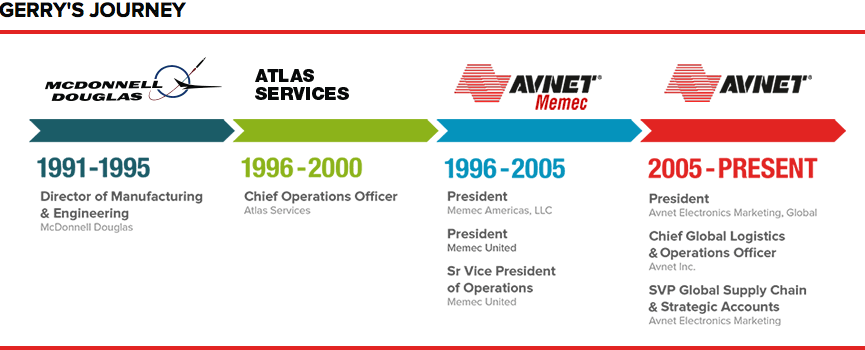With Avnet EM Global President Gerry Fay
Which factors are most commonly underestimated in the design and execution of a high-tech supply chain?
I think many companies still undervalue the role their supply chain can play in organizational success. Supply chains today are not just about promoting operational efficiency and cost cutting; when managed strategically, they truly can be vehicles for driving profitable growth and competitive advantage.
There is no one recipe for supply chain success, but one thing I can say for certain is that any supply chain that does not encourage collaboration with all its network partners is destined to perform, at best, sub-optimally. Win-lose supply chains just don’t cut it in today’s low-margin, fiercely competitive business environment.
Members of high-performing supply chains are committed to collaboration. They demonstrate it by showing respect for their trading partners, by being honest about not just their strengths, but their weaknesses as well, and they choose value over price. Think about how different the conversation—and subsequent relationship—is if you share what your pain points are and express interest in your supply chain partners’ key care-abouts. This collaborative approach invites everyone to bring his or her best capabilities and efforts to the problem and will invariably lead to a solution that works for everyone.

Which supply chain strategy/strategies do you believe OEMs should prioritize in 2015?
However, supporting a sense and respond supply chain requires partners to react more quickly. This requires more systems linkage and more openness to sharing information. It also forces more conscience decisions on what your supply is built to do, and how you will optimize for cost, risk or flexibility; all of these have tradeoffs that customers and their supply chain partners need to be fully aware of to maximize value. This helps all supply chain partners focus on what is most important and reduces friction between partners.
What will be the “game changers” in the hi-tech supply chain in the next five years?
One obvious game changer will be the ability to harness the power of the Internet of Things and big data to form actionable insights that can drive supply chain innovation and differentiation. Development of best practice capability in supply chain data analytics and the creation of world-class metrics and dashboards will be key to gaining the visibility and support necessary to drive greater agility and flexibility, while promoting more value-based decision making.
Wal-Mart identified an interesting example of the unique correlations this data can bring to light. The retail giant found that when a major storm is forecast in a region, customers not only bought emergency supplies like flashlights and batteries, but they also tended to stock up on Pop-Tarts. Now, Wal-Mart makes sure Pop-Tarts are a part of their storm preparation inventory.
Using robust dashboards, companies can also visualize how their supply chain is performing and identify where their weak links are. This is particularly valuable when the weak link is several tiers removed from the primary source of supply.
Less obvious, but equally impactful in the coming years, will be a best practice in proactive and multi-tiered risk management and business continuity. The volatility, complexity and uncertainty of market demand and the global economy, combined with factors such as geo-political instability, increased regulatory and environmental compliance and threat of natural disaster, assures that the likelihood and potential severity of a supply chain disruption are greater than ever. Too often, companies focus on the tactical supply chain level based on their “appetite” for risk, but fail to implement strategic supply chain resilience and business continuity processes. As incidences of disruptions increase, those able to recover the quickest will enjoy clear market leadership.
If you were advising a high-tech startup, what would you tell them is the key to profitability and/or success in today’s global electronic component supply chain?
Today’s entrepreneurs are born of a generation that is used to being interconnected and networked. Putting a sense and respond supply chain together and using analytics comes much more naturally for them. At the same time, however, enablers like crowd funding and maker spaces are thrusting many individuals with little to no business experience into this highly complex and competitive global supply chain environment. It can be overwhelming; so, I think my first piece of advice would be to keep things as simple as possible.
The fewer nodes you have in your supply chain, the less risk exposure you have and the higher value relationships you can create. This is definitely a case where strength does not necessarily come in numbers. When you drive new product development though a strategic group of suppliers, you cultivate relationships that not only yield cost reductions—through economies of scale and design and development efficiencies—but also encourages the kind of sharing and collaboration that can lead to breakthrough product and technology innovations. If you vette your supplier base carefully, interdependency is not a weakness.
On a more tactical level, I would advise these companies to be proactive in developing a lifecycle pricing strategy. As a product moves through its lifecycle, the cost to produce that product changes, as does the profitability. An effective lifecycle pricing strategy not only determines the extent to which your company benefits financially, but can also help reduce inventory and grow incremental annual revenue with no additional resource deployment.
It is one of the most innovative and exciting times to be a part of the electronics supply chain. I am tremendously inspired by the opportunity we, as members of the electronics supply chain community, have to help bring truly ground-breaking, life-altering products and services to a broader range of consumers and markets than ever before. Working together, we are making a significant difference in the world!
